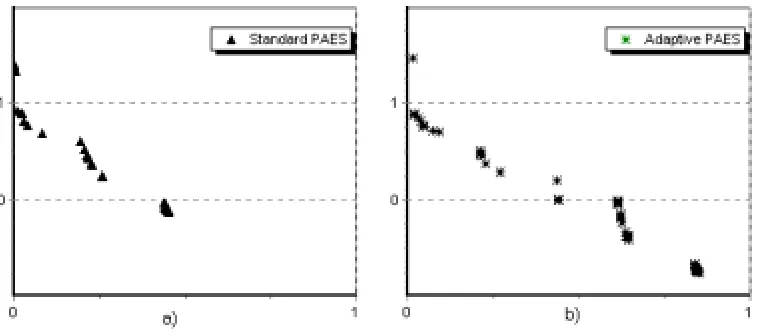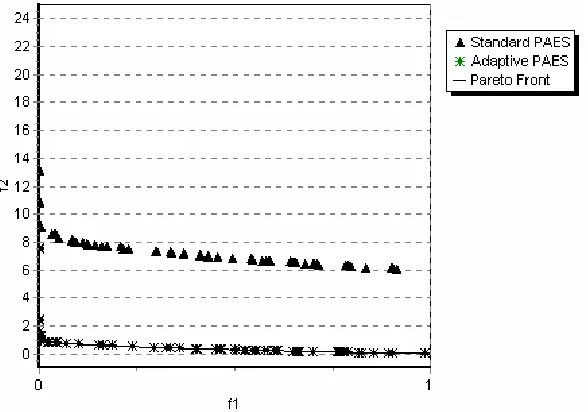A MODIFIED PAES ALGORITHM USING ADAPTIVE
REPRESENTATION OF SOLUTIONS
by
Crina Groşan, Mihai Oltean, Dan Dumitrescu
Abstract. Adaptive Representation Evolutionary Algorithm (AREA) is a new evolutionary paradigm that may be used for single and multiobjective optimization. AREA involves dynamic alphabets for encoding solutions. This encoding ensures an efficient exploration of the search space. In this paper a modified version of Pareto Archived Evolution Strategy (PAES) using AREA technique is proposed. The resulted algorithm is called Adaptive-PAES. Numerical experiments indicate that Adaptive-PAES perform significantly better than the standard PAES algorithm.
Keywords: Evolutionary Computation, Evolutionary Multiobjective Optimization, Pareto Set, Higher Alphabet Encoding, Adaptive Representation Adaptive PAES, Adaptive Pareto Algorithm.
I. Introduction
Many multiobjective optimization techniques using evolutionary algorithms have been proposed in recent years. Strength Pareto Evolutionary Algorithm (SPEA, [6, 7, 8]), Pareto Archived Evolution Strategy (PAES, [5]), Pareto Envelope – based Selection Algorithm (PESA, [1]), Nondominated Sorting Genetic Algorithm (NSGA II, [3]) and SPEA II ([9]) are very popular MultiObjective Evolutionary Algorithms (MOEAs).
In [4] a new evolutionary paradigm called Adaptive Representation Evolutionary Algorithm (AREA) for solving single and multiobjective problems has been proposed. Each AREA individual (chromosome) consists of a pair (x, B), where x
is a string encoding object variables and B specifies the alphabet used for encoding x.
x is a string of symbols over an alphabet {0,…, B-1}, B≥ 2. AREA technique permits individuals to be represented over different alphabets that are evolved during the search process.
In this paper AREA technique has been applied to Pareto Archived Evolution Strategy (PAES). The newly created algorithm is called Adaptive-PAES.
Numerical experiments with PAES and Adaptive-PAES techniques include several test functions reputed as difficult ([2, 6]).
II. Pareto Archived Evolution Strategy
Knowles and Corne [5] have proposed a simple evolutionary algorithm called Pareto Archived Evolution Strategy (PAES). In PAES one parent generates by mutation one offspring. The offspring is compared with the parent. If the offspring dominates the parent, the offspring is accepted as the next parent and the iteration continues. If the parent dominates the offspring, the offspring is discarded and the new mutated solution (a new offspring) is generated. If the offspring and the parent do not dominate each other, a comparison set of previously nondominated individuals is used.
For maintaining population diversity along Pareto front, an archive of nondominated solutions is considered. A new generated offspring is compared with the archive to verify if it dominates any member of the archive. If yes, then the offspring enters the archive and is accepted as a new parent. The dominated solutions are eliminated from the archive. If the offspring does not dominate any member of the archive, both parent and offspring are checked for their nearness with the solution of the archive. If the offspring resides in the least crowded region in the parameter space among the members of the archive, it is accepted as a parent and a copy is added to the archive.
The standard PAES algorithm is described in what follows:
Standard PAES Algorithm
repeat
Generate initial random solution c and add it to archive Mutate c to produce m and evaluate m
if c dominates m discard m
else
ifm dominates c
then replace c with m and add m to the archive else
else apply test (c, m, archive) to determine which becomes the new current solution and whether to add m to the archive
endif endif endif
until a termination criterion has been reached
III. AREA technique
The main idea of this technique is to allow each solution be encoded over a different alphabet. Moreover, the representation of a particular solution is not fixed. Representation is adaptive and may be changed during the search process as effect of mutation operator.
A) Solution representation
B is an integer number, B≥ 2 and x is a string of symbols from the alphabet {0, 1, …, B-1}. If B = 2, the standard binary encoding is obtained. The alphabet over which x is encoded may change during the search process.
If no ambiguity arises we will use B to denote the alphabet B = {0, 1,…B-1}. Example
An example of AREA chromosome is the following:
C = (x = 301453, B = 6)
Remark. Genes of x may be separated by comma if required.
B) Mutation
Mutation can modify object variables as well as the last position (fixing the representation alphabet).
When the changing gene belongs to the object variable sub-string (x – part of the chromosome), the mutated gene is a symbol randomly chosen from the same alphabet.
Example
Consider the chromosome C represented over the alphabet B = 8:
C = (x = 631751, B = 8).
If a mutation occurs on the position 3 in x then the mutated chromosome is:
If the position giving B is changed, then the object variables will be represented using symbols over the new alphabet, corresponding to the mutated value of B.
Example
Consider the chromosome C represented over the alphabet B = 8:
C = (x = 631751, B = 8).
If a mutation occurs on the last position (B) then the mutated chromosome is:
C2 = (x2 = 209897, B2 = 10).
Remark
C and C2 encode the same value over two different alphabets (B = 8, B2 = 10).
IV. Adaptive-PAES
In this section the modified PAES algorithm obtained by applying AREA technique is described.
The modification which occurs by applying AREA technique consists in what follows: when the current solution c dominates the mutated solution m for a consecutive fixed number of times it means that the representation of current solution has no potential for exploring the search space from the place where it belongs. Therefore the representation of the current solution must be changed in order to ensure a better exploration. In this respect the alphabet part of solution is changed into another random value.
The Adaptive-PAES algorithm is described in what follows:
Adaptive PAES
repeat
Generate initial random solution c and add it to archive
k = 0
Mutate c to produce m and evaluate m
if c dominates m then
k = k + 1; if k = 5 then
k = 0
ifm is dominated by any member of the archive discard m
else apply test (c, m, archive) to determine which becomes the new current solution and whether to add m to the archive
endif endif endif
until a termination criterion has been reached
V. Numerical experiments
In this section several experiments with Adaptive PAES and PAES are carried out. For these experiments two test functions reputed as difficult proposed in [2] (ZDT3 and ZDT4) are used.
Each test function considered in this section is built by using three functions
f1, g, h. Biobjective function T considered here is:
T(x) = (f1(x), f2(x)).
The optimization problem is:
Pareto optimal set corresponding to the test function ZDT3 presents a discrete feature. Pareto optimal front consists of several noncontiguous convex parts. The involved functions are:
Pareto optimal front is characterized by the equation
The introduction of the function sin in the expression of function h causes discontinuity in the Pareto optimal front. However, there is no discontinuity in the parameter space.
The test function ZDT4 contains 219 local Pareto optimal fronts and, therefore, it tests the EA ability to deal with multimodality. The involved functions are defined by:
Global Pareto optimal front is characterized by the equation
g(x)= 1.
The best local Pareto optimal front is described by the equation
g(x)= 1.25.
Note that not all local Pareto optimal sets are distinguishable in the objective space.
Each algorithm was run once on each test function.
Experiment 1
In this experiment the performances of Adaptive PAES and Standard PAES on test function ZDT3 are compared.
Algorithm parameters for PAES are given in Table 1.
Archive size 100
Number of iterations 25000 Chromosome length 900 genes
Mutation 1 mutation / chromosome
Algorithm parameters for Adaptive PAES are given in Table 2.
Archive size 100
Number of iterations 25000
Precision 0.00000001
Mutation 0.3 mutations / chromosome
Number of alphabets 30
Number of 5
Table 2. Algorithm parameters for Adaptive PAES.
In Figure 1 the nondominated solutions for PAES and Adaptive PAES on test function ZDT3 in objectives space are depicted.
Figure 1. a) Nondominated solutions for PAES. b) Nondominated
solutions for Adaptive PAES.
Standard PAES is able to detect only 3 optimal Pareto regions. Adaptive PAES detects 5 optimal Pareto regions.
Experiment 2
the ability of evolutionary algorithms to deal with multimodal search spaces. Algorithm parameters for PAES are given in Table 3.
Archive size 100
Number of iterations 25000 Chromosome length 300 genes
Mutation 8 mutation / chromosome
Table 3. Algorithm parameters for PAES. Algorithm parameters for Adaptive PAES are given in Table 4.
Archive size 100
Number of iterations 25000
Representation precision 0.00000001
Mutation 0.3 mutations / chromosome
Number of alphabets 30
Number of mutations until the representation of current solution is changed.
5
Table 4. Algorithm parameters for Adaptive PAES.
In Figure 2 the nondominated solutions for PAES and Adaptive PAES on test function ZDT4 in objectives space are depicted.
VI. Conclusions
In this paper a new evolutionary technique called AREA is used in order to improve the performances of a very known algorithm: PAES. A new evolutionary algorithm - called Adaptive PAES - for multiobjective optimization is obtained. Two test functions reputed as difficult are used to realize a comparison between standard PAES algorithm and the new obtained algorithm – Adaptive PAES. The results show that Adaptive PAES performs better than standard PAES algorithm.
References
[1].D.W.Corne, J.D. Knowles, The Pareto-Envelope based Selection Algorithm for Multiobjective Optimization. In Proceedings of the Sixth International Conference on Parallel Problem Solving from Nature, Springer-Verlag, Berlin, 2000, pp 839-848. [2].Deb, K., Multi-objective genetic algorithms: Problem difficulties and construction of test functions. EvolutionaryComputation, 7(3), (1999), pp. 205-230.
[3].Deb, K., S. Agrawal, Amrit Pratap and T. Meyarivan, A fast elitist non – dominated sorting genetic algorithm for multi-objective optimization: NSGA II. In M. S. et al. (Ed), Parallel Problem Solving From Nature – PPSN VI, Berlin, (2000), pp. 849 – 858. Springer.
[4].Dumitrescu, D., Groşan, C., Oltean, M., A new evolutionary adaptive representation paradigm, Studia Universitas Babes--Bolyai, Seria Informatica, Volume XLVI, No. 1, p. 15-30, 2001.
[5].Knowles, J. D. and Corne, D. W., The Pareto archived evolution strategy: A new baseline algorithm for Pareto multiobjective optimization. In Congress on Evolutionary Computation (CEC 99), Volume 1, Piscataway, NJ, (1999), pp. 98 – 105. IEEE Press.
[6].Zitzler, E., Evolutionary algorithms for multiobjective optimization: Methods and Applications. Ph. D. thesis, Swiss Federal Institute of Technology (ETH) Zurich, Switzerland. TIK – Schriftenreiche Nr. 30, Diss ETH No. 13398, (1999), Shaker Verlag, Aachen, Germany.
[7].Zitzler, E. and Thiele, L., Multiobjective evolutionary algorithms: A comparative case study and the strength Pareto approach. IEEE Transaction on Evolutionary Computation 3(4), (1999), pp. 257 – 271.
[9].Zitzler, E., Marco Laumanns and Thiele, L., SPEA 2: Improving the Strength Pareto Evolutionary Algorithm, TIK Report 103, Computer Engineering and Networks Laboratory (TIK), Departament of Electrical Engineering Swiss federal Institute of Technology (ETH) Zurich, 2001.
Authors:


